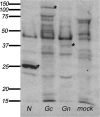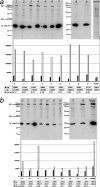Prevalence and protein specificity of human antibodies to Inkoo virus infection
- PMID: 17942611
- PMCID: PMC2168378
- DOI: 10.1128/CVI.00288-07
Prevalence and protein specificity of human antibodies to Inkoo virus infection
Abstract
Inkoo virus (INKV), a member of the California serogroup orthobunyaviruses, is circulating widely in northern Europe. Although the virus was discovered over 40 years ago, the disease associations and immune responses in human infection are poorly characterized. We first developed an immunofluorescence assay (IFA) for the detection of INKV antibodies in humans, and then we studied a panel of 1,292 sera in patients with a febrile illness in Finland. We found four acute (immunoglobulin M [IgM] positive) INKV infections and an IgG seroprevalence of 51.3%. The data indicate that the infection has become more common than it was in the 1960s, especially in southern Finland. Two distinct IgG IFA fluorescence patterns were observed: a granular pattern in sera from patients with acute INKV infection and a diffuse pattern in those with long-standing immunity. Further analysis with a panel of INKV-positive sera (n = 18; verified by neutralization assay) of protein-specific responses, using immunoprecipitation and IFA based on baculovirus-expressed INK N, Gn, and Gc proteins, demonstrated a strong IgG response predominantly towards N protein in the acute phase. In contrast, in patients with long-standing immunity, the Gc response was more prominent and the N response was weaker. In conclusion, a diagnostic IgG IFA pattern distinguishing between acute infection and long-standing immunity was observed. N protein seems to be the optimal antigen for the serodiagnosis of acute infection, and the Gc protein could be appropriate for the serosurveillance of INKV.
Figures





Similar articles
-
Seroprevalence and Risk Factors of Inkoo Virus in Northern Sweden.Am J Trop Med Hyg. 2016 May 4;94(5):1103-1106. doi: 10.4269/ajtmh.15-0270. Epub 2016 Feb 29. Am J Trop Med Hyg. 2016. PMID: 26928830 Free PMC article.
-
Detection of California Serogroup Orthobunyavirus antibodies and Inkoo virus RNA in patients, Finland.Epidemiol Infect. 2025 Jul 17;153:e83. doi: 10.1017/S0950268825100289. Epidemiol Infect. 2025. PMID: 40671600 Free PMC article.
-
Acute Human Inkoo and Chatanga Virus Infections, Finland.Emerg Infect Dis. 2016 May;22(5):810-7. doi: 10.3201/eid2205.151015. Emerg Infect Dis. 2016. PMID: 27088268 Free PMC article.
-
Investigations on California serogroup orthobunyaviruses in the Tyrols: first description of Tahyna virus in the Alps.Vector Borne Zoonotic Dis. 2014 Apr;14(4):272-7. doi: 10.1089/vbz.2013.1360. Epub 2014 Apr 1. Vector Borne Zoonotic Dis. 2014. PMID: 24689784
-
Detection of Schmallenberg virus serum neutralising antibodies.J Virol Methods. 2013 Mar;188(1-2):139-44. doi: 10.1016/j.jviromet.2012.11.031. Epub 2012 Nov 29. J Virol Methods. 2013. PMID: 23201289 Review.
Cited by
-
The Adaptive Immune Response against Bunyavirales.Viruses. 2024 Mar 21;16(3):483. doi: 10.3390/v16030483. Viruses. 2024. PMID: 38543848 Free PMC article. Review.
-
Seroprevalence and Risk Factors of Inkoo Virus in Northern Sweden.Am J Trop Med Hyg. 2016 May 4;94(5):1103-1106. doi: 10.4269/ajtmh.15-0270. Epub 2016 Feb 29. Am J Trop Med Hyg. 2016. PMID: 26928830 Free PMC article.
-
Detection of California Serogroup Orthobunyavirus antibodies and Inkoo virus RNA in patients, Finland.Epidemiol Infect. 2025 Jul 17;153:e83. doi: 10.1017/S0950268825100289. Epidemiol Infect. 2025. PMID: 40671600 Free PMC article.
-
Mosquito-borne Inkoo virus in northern Sweden - isolation and whole genome sequencing.Virol J. 2017 Mar 23;14(1):61. doi: 10.1186/s12985-017-0725-5. Virol J. 2017. PMID: 28330505 Free PMC article.
-
Detection of Sindbis and Inkoo Virus RNA in Genetically Typed Mosquito Larvae Sampled in Northern Sweden.Vector Borne Zoonotic Dis. 2016 Jul;16(7):461-7. doi: 10.1089/vbz.2016.1940. Epub 2016 May 9. Vector Borne Zoonotic Dis. 2016. PMID: 27159120 Free PMC article.
References
-
- Bardos, V., M. Medek, V. Kania, and Z. Hubalek. 1975. Isolation of Tahyna virus from the blood of sick children. Acta Virol. 19:447. - PubMed
-
- Brummer-Korvenkontio, M. 1973. Arboviruses in Finland. V. Serological survey of antibodies against Inkoo virus (California group) in human, cow, reindeer, and wildlife sera. Am. J. Trop. Med. Hyg. 22:654-661. - PubMed
-
- Brummer-Korvenkontio, M. 1974. Bunyamwera arbovirus supergroup in Finland, A study on Inkoo and Batai viruses. Commentationes Biologicae. 76:1-52.
-
- Brummer-Korvenkontio, M., P. Saikku, P. Korhonen, I. Ulmanen, T. Reunala, and J. Karvonen. 1973. Arboviruses in Finland. IV. Isolation and characterization of Inkoo virus, a Finnish representative of the California group. Am. J. Trop. Med. Hyg. 22:404-413. - PubMed
-
- Bupp, K., K. Stillmock, and F. Gonzalez-Scarano. 1996. Analysis of the intracellular transport properties of recombinant La Crosse virus glycoproteins. Virology 220:485-490. - PubMed
Publication types
MeSH terms
Substances
LinkOut - more resources
Full Text Sources
Miscellaneous

